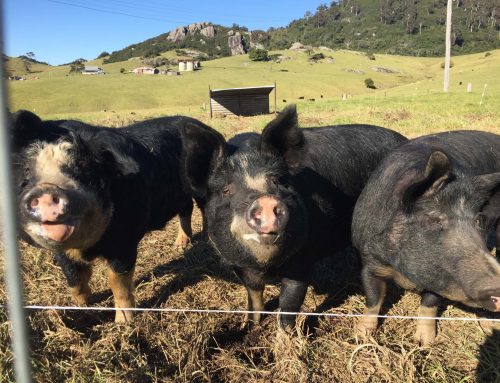By Jamie Kronborg. First published in the Ovens & Murray Advertiser, Beechworth, May 27, 2015.
WOORAGEE lamb producer Anne Stelling believes that it would take just a little co-operative smart thinking to work through some regulatory ‘roadblocks’ for the North East to develop a significant – and diverse – local food network.
Anne and her sister Fleur produce first cross lambs, geese, eggs and wine grapes on a 75-hectare farm north of Beechworth and have established a local market for their lamb. But it is a market stitched together with ingenuity that enables the family to maintain all of the benefits of ‘small’ in an industry traditionally geared to large-scale production.
The Stellings turn off 50-60 first-cross lambs a year – most of which are sold in the Corowa saleyards. But Anne has also worked hard to build a local market for their Suffolk-cross meat branded as ‘Weeping Grass Creek’ lamb.
Anne has drawn on Wangaratta abattoir’s willingness to kill small lots of a few animals and the skills of Beechworth’s Luke Whybrow to butcher each carcase to buyer requirements without breaching a strict food regulatory regime.
“I’ve been on this farm since 1997 and we started selling lamb direct to people probably eight years ago,” Anne said.
“It was just serendipity because we usually just breed them and take them off to market, down to Corowa in the trailer.
“My cousins came out one day from Albury for lunch and said: ‘How can we get some of this lamb?’ – and I said ‘Well, you can get it from me’.
“Then I thought there are probably other people who might like a farm contact so I told them if you know anyone else who wants some, then we can look at ways of supplying them.
“I’ve since been trialling all these ways of managing it, and that’s when I really started to get interested in local food.”
One of the challenges has been a regulation that prohibits the sale of meat directly from farmers to would-be customers.
Anne can sell only a live animal but has developed a local market for her lamb by arranging to have it slaughtered and butchered to her customer’s requirements.
“So I sell a live lamb but people pick them up in from the butcher in a box,” she said.
“(Luke) is very good and some people are quite particular about how they want their lamb cut up, or maybe they want it marinated, and he can do all of that – so that’s what we do.”
Anne’s development of an ‘order-by-email market’ enables her to arrange processing of just eight lambs because that’s the limit of the Whybrows’ butchery capacity. But it’s dependent on the willingness of the Wangaratta abattoir to slaughter small lots – and it’s also a potential risk to her developing business.
“I’ve got a philosophical bent towards producing and supplying local – and no doubt I could sell it in Melbourne, but it would be a big step up for me and probably I haven’t enough lambs to supply that anyway,” Anne said.
Australian agriculture in the past 50-60 years has not been geared to supplying a local market.
“It’s exactly the opposite. It’s all geared to this so-called ‘feeding the world’ and big agriculture and exports and economies of scale which make it quite difficult.
“But in other countries this happens.In Laos 86 per cent of food is provided by subsistence agriculture, which is local people feeding their families and village communities.
“So it’s not impossible. Yet it’s derided as subsistence and the question is asked: ‘Why would we want to do that?’”
Anne believes a strong local food market would certainly build local food security.
“I would really like to see local, state and federal governments give an equal focus to empowering local (food) networks, looking at it in terms of real food security and trying to set in place the systems that will help that rather than hinder it,” she says.
“I’d like to see how we could get some co-operative ownership of equipment, like an olive press – so people with three or four trees could have their fruit crushed – and if there was some way to have a mobile abattoir that would come to my place and we could process the lambs here and have it done by a butcher.
“Being able to have local multi-purpose, multi-species mobile or processing facilities close-by would be very helpful.”




